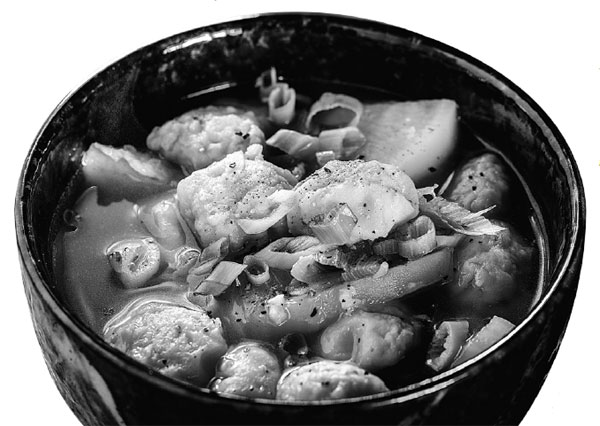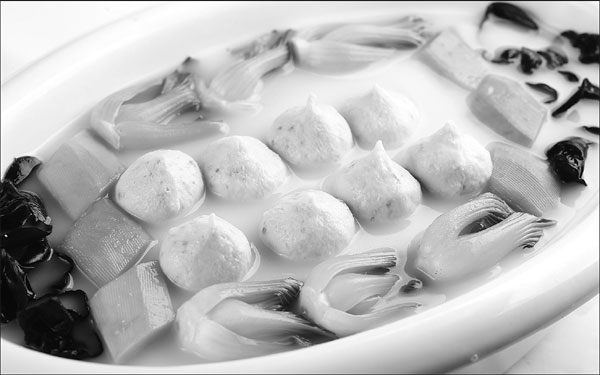The miracle of fish paste
Fish is eaten throughout the world wherever there is water. Fishing was one of the first skills mastered by our ancestor hunter-foragers, so the cooking of fish is an ancient art.
I have eaten fish in many places, from east to west, and I like the Chinese attitude toward fish best. It is disarmingly honest.
In Western countries, fish tends to be neatly filleted and deboned, so much so that the anonymous fillet can no longer be identified and you have to depend on the label to know what you are buying.
|
All over China, especially in the southern coastal regions, entire market stalls are devoted to delicacies made from pounded fish meat. Photos Provided to China Daily |
When I first went abroad as a teenage student, I suffered a sort of reverse culture shock when I was served fish in boarding school. I couldn't believe that it was fish. All the delicious gelatinous parts around the head and tail were nowhere in sight and the tender belly bits which grandfather always reserved for me were missing.
Over time, I got used to the convenience of fish fillets, but then I started missing fish cakes, fish tofu, fish balls and fish crackers.
Over time again, I discovered these fish products in the nearest Chinatowns, and through frequent hotpot parties, I introduced my closest friends to the pleasure of eating fish products.
These are uniquely Chinese, I discovered. All over China, especially in the southern coastal regions, entire market stalls are devoted to these delicious delicacies made from pounded fish meat.
The fish paste is stuffed into vegetables like green chili peppers, slices of hollowed out bitter melon, aubergine sandwiches or sheets of steamed or deep-fried bean curd skin.
Or, the fish paste is molded in fat round globes the size of ping pong balls, shaped into patties, and steamed or shallow fried to help extend their shelf life.
Fresh fish paste is sometimes sold by the tub, for the home cook to take home. Once in the kitchen, it is mixed with egg or tofu and steamed for an easy dish suitable for young and old.
More often than not, the fish paste is dropped into boiling soup for yet another simple but tasty addition to the dining table.
That's not all. Fish meat is also steamed, sliced and sun-dried to produce crisp crunchy crackers. Some fish crackers are more robust and are semi-dried, only to be rehydrated again in soups and stews.
In my own childhood, fish paste was made at home.
The cheaper varieties of sea fish such as mackerel or bream were bought by the kilo. The fish were halved down the backbone and an essential tool brought out. A tablespoon.
My grandmother would carefully scrape the spoon down the fillet, removing the flesh and pick off any stray bones. By the time she had finished, there would be just the skin left on the chopping board.
The basin of fish meat would be chopped up fine. A little tapioca starch would go in and the vigorous stirring began, always in one direction. She would sprinkle brine onto the mixture, judging only through touch when the fish paste was ready.
Wetting her hands, she would start forming fish balls and patties, dropping them into salted water to keep their shape.
Her fish balls were always perfect, savory and so bouncy they were a pleasure to bite into.
Nothing was ever wasted. The bones of the fish were fried and made into sweet fish stock, and the skin carefully air dried, dusted with flour and deep fried as a treat.
Few people have the time or the skill to make their own fish paste anymore and over-fished seas mean that varieties like bream or mackerel are now priced beyond reach.
Most commercial fish paste are now made with a mixed variety of fish such as hairtail and eel, with various additives to make them taste "good".
In Shunde, Guangdong province, they use farmed freshwater fish for fish paste. The grass carp, reared in the mulberry-fringed ponds, is a typically bony fish full of y-shaped fine bones.
But Shunde chefs have long learned to harness the fish with their cooking skills, making a fish paste that they turn into delicious dishes and snacks.
The fish meat is seasoned heavily, and aged citrus peel is added to banish the muddy taste of freshwater fish. One of the most famous dishes on the Cantonese dim sum table is carp meatballs, deep fried and served with a wine-pickled clam sauce.
Another wonderful fish paste dish is a fish, deboned but with the skin intact. The meat is minced and then stuffed back into the skin. The stuffed fish is then carefully deep-fried and then served whole in the perfect showcase of culinary artifice.
That is only one example of how the Chinese chefs have honed their skills through the ages using one of their favorite ingredients - fish paste.
paulined@chinadaily.com.cn
|
Fish ball soup with carrot, Chinese black fungus and Chinese cabbage. |

(China Daily Global 08/21/2019 page15)




















